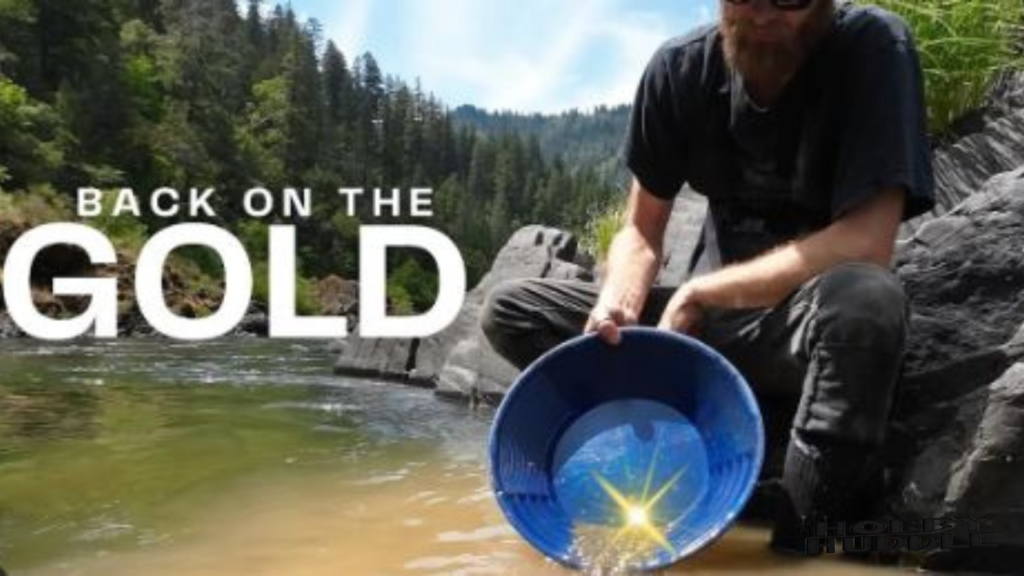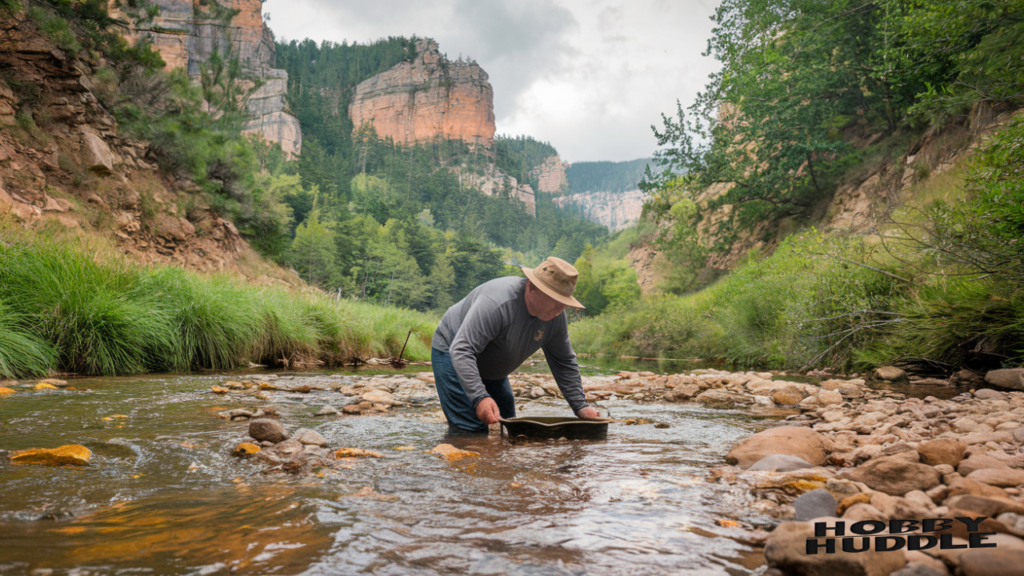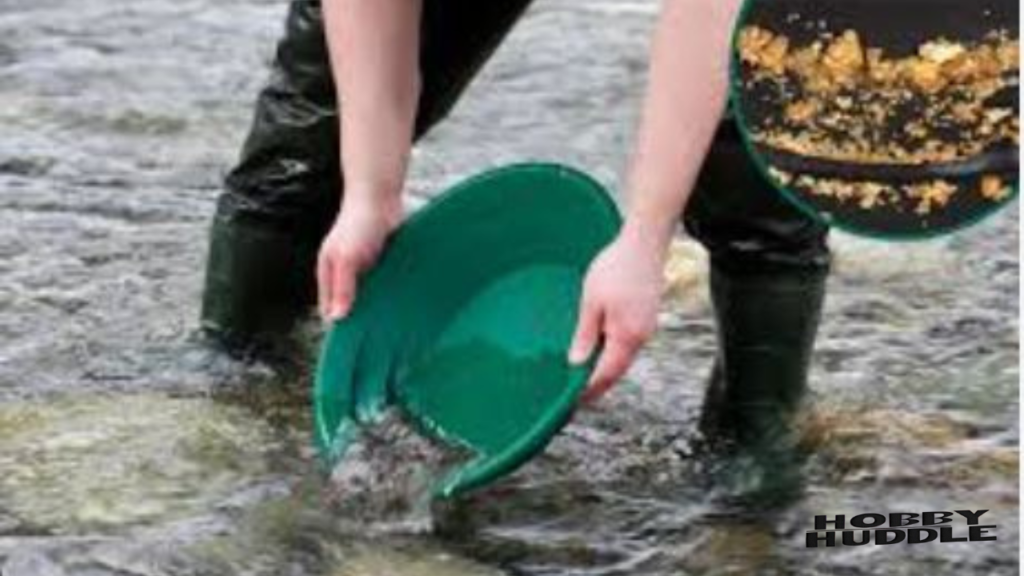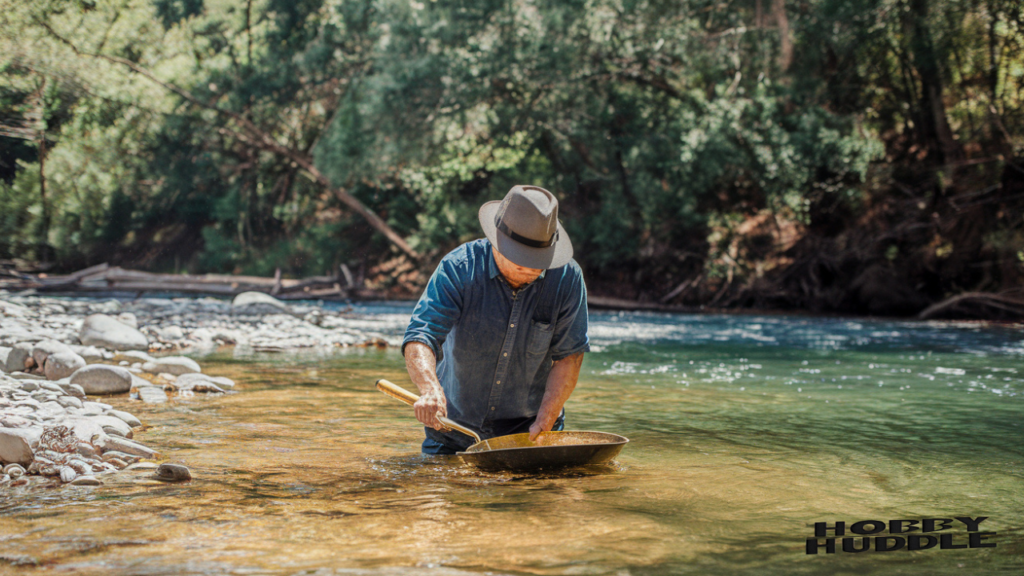The rich history of gold panning in South Carolina stretches back over two centuries, marking the state as a significant player in America’s gold mining legacy.
Long before the California Gold Rush captured the nation’s imagination, prospectors were discovering valuable deposits throughout the Carolina Slate Belt, a geological formation that has yielded countless precious minerals since the late 18th century.
Early Discoveries and Historical Impact
The story of gold mining history in South Carolina begins with a chance discovery in 1799 by Conrad Reed, who found a peculiar yellow rock in Little Meadow Creek. That seemingly insignificant finding sparked a revolution in American mining history, leading to the establishment of numerous mining operations throughout the region.
The Birth of Commercial Mining
James Dorn’s remarkable discovery in McCormick County transformed casual gold prospecting into a serious industry. His finding led to the establishment of the famous Dorn Gold Mine, which produced over $900,000 in gold by 1859. The success of early ventures like these attracted prospectors from across the nation, establishing South Carolina as a premier destination for gold mining.
Here’s a comprehensive look at the historical gold production from major South Carolina mines between 1800 and 1900:
| Mine Name | Location | Total Gold Production (Troy Ounces) | Years Active |
|---|---|---|---|
| Haile Gold Mine | Kershaw | 150,000 | 1827-1900 |
| Dorn Mine | McCormick | 45,000 | 1852-1878 |
| Brewer Mine | Chesterfield | 37,000 | 1828-1887 |
| Ferguson Mine | York | 25,000 | 1835-1880 |
| Reed Mine | Lancaster | 22,000 | 1829-1875 |
| Gardner Mine | Cherokee | 18,500 | 1840-1882 |
| Martin Mine | Union | 15,000 | 1845-1870 |
| Blackmon Mine | Lancaster | 12,500 | 1838-1865 |
| Magnolia Mine | York | 10,800 | 1850-1885 |
| Smith Mine | Union | 9,500 | 1842-1868 |
You Might Like: Gold Panning in Georgia | An Ultimate Guide for 2024
Modern Gold Prospecting Opportunities
Today, gold prospecting SC continues to attract both seasoned miners and newcomers. The Haile Gold Mine, recently reopened with modern technology, stands as a testament to the enduring value of South Carolina’s gold deposits. This operation employs state-of-the-art extraction methods while maintaining environmental responsibility.

Understanding South Carolina’s Gold Deposits
The geological formation known as the Carolina Slate Belt runs from Virginia through South Carolina, creating ideal conditions for gold formation. This region’s unique characteristics make it particularly promising for both placer gold and lode gold deposits. Understanding the difference between these two types is crucial for successful prospecting.
Essential Geological Knowledge
Prospectors must understand the distinction between placer vs lode gold deposits. Placer deposits occur in streams and rivers, where natural erosion has transported gold from its original source. Lode deposits, conversely, remain embedded in solid rock formations, typically within quartz veins.
Popular Prospecting Locations
The Broad River remains one of the most popular destinations for modern prospectors. Its waters have consistently yielded impressive finds, particularly after heavy rains when new deposits are exposed. Oconee Creek and its tributaries also offer promising opportunities for both novice and experienced panners.
Legal Considerations and Permits
Before beginning any gold prospecting activities, understanding gold mining laws SC is essential. The state’s Department of Health and Environmental Control (DHEC) oversees mining activities and issues necessary permits. The distinction between public vs private lands significantly impacts where and how you can prospect.
Understanding Mining Regulations
Modern gold mining permits SC requirements reflect a balance between enabling prospecting activities and protecting natural resources. Prospectors must navigate various environmental regulations while pursuing their golden aspirations. This regulatory framework ensures sustainable mining practices for future generations.
Here’s a current overview of prospecting permit requirements and fees for 2024:
| Permit Type | Duration | Fee | Requirements |
|---|---|---|---|
| Recreational Panning | Annual | $25 | Basic ID and Application |
| Small-Scale Mining | 2 Years | $150 | Environmental Assessment |
| Commercial Operation | 5 Years | $500 | Full Impact Study |
| Educational Group | 6 Months | $75 | Institution Affiliation |
| Weekend Prospector | 3 Months | $40 | Basic Training |
| Professional Guide | Annual | $200 | Experience Proof |
| Equipment Operation | Annual | $175 | Safety Certification |
| Land Restoration | Project Based | $300 | Restoration Plan |
| Water Use Permit | Annual | $125 | Water Quality Plan |
| Historic Site Access | 6 Months | $100 | Heritage Assessment |
As we continue exploring this fascinating topic, subsequent sections will delve deeper into specific techniques, equipment recommendations, and detailed location guides. The rich heritage of gold mining in South Carolina continues to evolve, offering exciting opportunities for those willing to learn and respect the state’s golden legacy.
You Might Like: Gold Panning in Missouri | A Gold Prospecting Guide for 2024
Essential Equipment for Success
Modern gold panning techniques require specific tools and equipment for optimal results. The choice of equipment can significantly impact your success rate when gold prospecting. From basic pans to more sophisticated devices, each tool serves a unique purpose in the prospecting process.

Basic Equipment Overview
Your success in gold panning South Carolina largely depends on having the right prospecting equipment. A basic gold pan remains the fundamental tool, but serious prospectors often invest in additional equipment like sluice boxes and classifying screens. These tools help process larger volumes of material more efficiently.
Here’s a comprehensive breakdown of essential equipment costs and characteristics:
| Equipment Type | Average Cost | Durability Rating | Best Usage Scenario |
|---|---|---|---|
| Professional Pan | $15-25 | 8-10 years | All Conditions |
| Sluice Box | $89-200 | 5-7 years | Moving Water |
| Metal Detector | $400-800 | 3-5 years | Dry Land |
| Classification Screen | $30-50 | 4-6 years | Material Sorting |
| Stream Shovel | $35-45 | 2-3 years | Wet Conditions |
| Gold Snifter Bottle | $8-12 | 1-2 years | Fine Gold |
| Premium Tweezers | $15-20 | 4-5 years | Nugget Handling |
| Hand Dredge | $150-200 | 3-4 years | Deep Pools |
| Crevicing Tools | $40-60 | 6-8 years | Rock Work |
| Safety Equipment | $100-150 | 2-3 years | All Scenarios |
Advanced Prospecting Methods
Understanding advanced gold deposits identification techniques can dramatically improve your success rate. Professional prospectors often combine traditional panning with modern technology. The presence of black sand and specific mineral indicators often signals potentially productive areas.
Reading the Land
The ability to identify promising locations for gold mining South Carolina requires understanding geological indicators. Quartz veins often signal potential lode gold deposits, while river bends and natural traps commonly hold placer gold deposits.
The Carolina Slate Belt
The Carolina Slate Belt represents one of the most significant geological features for prospectors. This ancient volcanic formation stretches across the state, creating ideal conditions for gold formation. Understanding its characteristics helps in identifying promising prospecting locations.

Notable Mining Operations
The Haile Gold Mine stands as the most prominent example of successful mining within the Carolina Slate Belt. Similarly, the historical Ridgeway Gold Mine demonstrated the region’s rich potential. These operations provide valuable insights into local geology and gold distribution patterns.
Here’s an analysis of current prospecting hotspots within the Carolina Slate Belt:
| Location | Success Rate | Accessibility | Best Season |
|---|---|---|---|
| Little Meadow Creek | High | Moderate | Spring |
| Broad River North | Medium | Easy | Summer |
| Walhalla District | High | Difficult | Fall |
| Kershaw Area | Very High | Restricted | Winter |
| McCormick Region | Medium | Easy | Spring |
| Clemson Territory | Low | Easy | Summer |
| Cherokee Falls | Medium | Moderate | Fall |
| Lancaster District | High | Limited | Spring |
| Union County Sites | Medium | Moderate | Summer |
| York Gold Belt | High | Difficult | Fall |
You Might Like: 1973 Penny Coin Value [Error List, “D”, “S” & No Mint Mark Worth]
Seasonal Prospecting Strategies
Success in gold prospecting often depends on choosing the right season. Spring typically offers ideal conditions after winter rains have exposed new deposits. Summer allows easier access to normally submerged areas, while fall presents unique opportunities in drought-lowered streams.
Weather Considerations
Rainfall patterns significantly impact river gold panning success rates. Heavy rains can expose new deposits but may also make some areas temporarily inaccessible. Understanding these patterns helps in planning productive prospecting trips.
Safety and Environmental Responsibility
Modern gold mining requires careful attention to environmental preservation. The state’s environmental regulations ensure sustainable prospecting practices while protecting natural resources. Responsible prospectors always minimize their impact on the environment.
Documentation Requirements
Maintaining proper documentation proves essential for legal gold prospecting SC. This includes keeping copies of permits, landowner permissions, and any required environmental impact assessments. Professional prospectors often maintain detailed logs of their activities and findings.
Here’s a current overview of common environmental considerations and their importance ratings:
| Environmental Factor | Impact Level | Mitigation Required | Monitoring Frequency |
|---|---|---|---|
| Water Quality | Critical | Extensive | Daily |
| Soil Erosion | High | Moderate | Weekly |
| Wildlife Impact | Medium | Basic | Monthly |
| Vegetation Damage | Medium | Basic | Monthly |
| Noise Pollution | Low | Minimal | As Needed |
| Chemical Usage | Critical | Extensive | Daily |
| Waste Management | High | Moderate | Weekly |
| Air Quality | Low | Minimal | Monthly |
| Land Restoration | Critical | Extensive | Post-Activity |
| Habitat Protection | High | Moderate | Continuous |
The importance of understanding these various aspects of gold prospecting cannot be overstated. Success in gold mining requires a combination of knowledge, proper equipment, and respect for both legal requirements and environmental considerations. As we continue exploring this topic, subsequent sections will delve deeper into specific techniques and location-specific advice.
Professional Techniques and Methods
Understanding advanced gold panning techniques can significantly increase your chances of success. Professional prospectors employ various methods depending on the terrain and type of deposit. These techniques have evolved significantly since the early days of the California Gold Rush.
Understanding Gold Movement
The principles of gold movement in streams remain crucial for successful gold prospecting SC. Heavy rains and seasonal flooding can redistribute gold deposits, creating new opportunities in previously worked areas. Professional prospectors often track weather patterns to predict optimal prospecting times.
Here’s a detailed analysis of common prospecting techniques and their effectiveness:
| Technique | Success Rate | Physical Effort | Time Investment | Best Conditions |
|---|---|---|---|---|
| Traditional Panning | 65% | Moderate | 2-3 hours | Clear water |
| Sluicing | 75% | High | 4-6 hours | Moving water |
| Crevicing | 80% | Very High | 3-4 hours | Low water |
| Metal Detecting | 70% | Low | 5-6 hours | Dry ground |
| Dredging | 85% | Extreme | 6-8 hours | Deep pools |
| Highbanking | 78% | High | 5-7 hours | Bank access |
| Drywashing | 60% | Moderate | 4-5 hours | Arid conditions |
| Rock Breaking | 72% | Very High | 3-5 hours | Exposed bedrock |
| Classification | 68% | Low | 2-3 hours | Any condition |
| Beach Panning | 55% | Low | 3-4 hours | After storms |
Location Selection Strategies
Choosing the right location for gold mining South Carolina requires understanding historical patterns and geological indicators. The Carolina Slate Belt contains numerous promising areas, particularly around historic mining sites like the Haile Gold Mine and Ridgeway Gold Mine.
Historical Site Assessment
Learning from historical gold mining history can provide valuable insights. Many modern discoveries occur near abandoned mine sites where earlier technologies couldn’t extract all available gold. Understanding past mining operations helps identify promising new locations.
Understanding Deposit Types
The distinction between placer vs lode gold deposits significantly impacts prospecting strategies. Placer deposits, found in streams and river beds, require different techniques than lode deposits embedded in rock formations. Each type demands specific equipment and approaches.
Modern Prospecting Innovations
Recent technological advances have revolutionized gold deposits identification. Modern prospectors combine traditional knowledge with new tools like mineral detectors and geological mapping software. This fusion of old and new methods increases success rates significantly.
Here’s a comparison of different deposit types and their characteristics:
| Deposit Type | Formation Process | Typical Depth | Equipment Needed | Access Difficulty |
|---|---|---|---|---|
| Surface Placer | Water Erosion | 0-2 feet | Basic Pan | Easy |
| Deep Placer | Ancient Streams | 2-10 feet | Dredge | Moderate |
| Bench Deposits | Old River Beds | 5-15 feet | Highbanker | Hard |
| Lode Veins | Primary Formation | 10+ feet | Heavy Equipment | Very Hard |
| Eluvial | Weathering | 1-5 feet | Metal Detector | Moderate |
| Contact Zones | Geological Boundary | Various | Mixed Tools | Variable |
| Stream Placers | Active Rivers | 0-4 feet | Sluice Box | Easy |
| Desert Placers | Wind Action | 0-3 feet | Dry Washer | Moderate |
| Glacial Deposits | Ice Movement | Various | Mixed Methods | Hard |
| Pocket Gold | Concentrated Veins | Various | Rock Tools | Very Hard |
Area Access and Permissions
Understanding mining regulations becomes crucial when accessing different locations. The distinction between public vs private lands affects where and how you can prospect. Proper permits and permissions prevent legal issues and ensure sustainable access to prospecting areas.
Navigating Property Rights
Successful gold prospecting requires understanding and respecting property boundaries. Many promising areas lie on private property, requiring explicit permission from landowners. Here’s a current analysis of accessible prospecting locations:
| Location Name | Access Type | Permit Required | Best Season | Success Potential |
|---|---|---|---|---|
| Broad River | Public | Basic Permit | Spring | High |
| Little Meadow | Private | Owner Permission | Summer | Very High |
| Walhalla Area | Mixed | Multiple Permits | Fall | Moderate |
| Kershaw Region | Restricted | Special Access | Winter | Very High |
| McCormick Sites | Public | Basic Permit | Spring | High |
| Oconee Creek | Public | Basic Permit | Summer | Moderate |
| Cherokee Area | Private | Owner Permission | Fall | High |
| Lancaster Zone | Mixed | Multiple Permits | Spring | Very High |
| Union District | Public | Basic Permit | Summer | Moderate |
| York Territory | Restricted | Special Access | Fall | High |
Equipment Maintenance
Proper care of your gold prospecting equipment ensures optimal performance and longevity. Regular maintenance prevents equipment failure during crucial prospecting sessions. Professional prospectors often maintain backup equipment for critical components.
Tool Selection and Care
Choosing appropriate tools for specific conditions improves efficiency in gold mining. Different locations and deposit types require varying equipment combinations. Understanding when to use each tool maximizes productivity and minimizes wasted effort.
Identifying and Extracting Gold
Recognizing the visual characteristics of gold is a crucial skill for successful gold prospecting SC. From the glimmer of a gold nugget to the presence of black sand, prospectors must develop a keen eye for detecting valuable deposits.
Visual Indicators of Gold
The ability to identify placer gold and lode gold is essential for effective prospecting. Prospectors must learn to distinguish gold from other metallic minerals like pyrite, which is commonly mistaken for the real thing. Paying close attention to the color, shape, and texture of potential finds is key.
Here’s a visual guide to help identify different forms of gold:
| Gold Type | Color | Shape | Texture |
|---|---|---|---|
| Nuggets | Bright Yellow | Irregular, Rounded | Smooth, Shiny |
| Flakes | Pale Yellow | Thin, Flat | Smooth, Glittery |
| Dust | Pale Yellow | Fine Powder | Smooth, Dull |
| Chunks | Bright Yellow | Jagged, Angular | Rough, Uneven |
| Veins | Bright Yellow | Embedded in Rock | Rough, Crystalline |
| Black Sand | Dark Gray/Black | Fine Grains | Gritty, Dense |
Extraction Techniques
Once gold has been identified, the next step is efficient extraction. Panning, sluicing, and dredging are among the most common techniques used by prospectors in South Carolina. Each method has its own advantages depending on the deposit type and location.
Panning for Gold
The classic gold panning technique remains one of the most effective ways to extract placer gold from streams and rivers. This method requires patience, skill, and a keen eye for spotting valuable deposits. Proper panning technique maximizes the chances of success.

Sluicing for Higher Yields
For higher volume extraction, many prospectors turn to sluice boxes. These devices use the power of moving water to separate gold from other sediments. Sluicing is particularly effective in areas with known placer gold deposits.
Dredging for Deeper Deposits
In deeper pools and river beds, gold dredging becomes the preferred extraction method. This technique involves using a suction dredge to agitate the riverbed and capture heavier gold particles. Dredging requires more specialized equipment and skills but can yield impressive results.
Crevicing for Lode Gold
Prospectors seeking lode gold often turn to crevicing, a technique that involves carefully extracting gold-bearing material from cracks and crevices in exposed bedrock. This meticulous process requires patience and the right set of tools.
Regulatory Compliance and Sustainable Practices
Responsible gold mining in South Carolina requires strict adherence to state regulations and a commitment to environmental stewardship. Prospectors must obtain the necessary permits, follow proper procedures, and ensure their activities have minimal impact on the surrounding ecosystem.
Permit and Reporting Requirements
Obtaining the correct permits is a crucial first step in legal gold prospecting SC. Prospectors must understand the different permit types, their associated fees, and any additional reporting or monitoring requirements. Maintaining detailed records of all activities is essential for compliance.
Here’s a summary of key permit types and their associated requirements:
| Permit Type | Duration | Fee | Key Requirements |
|---|---|---|---|
| Recreational Panning | Annual | $25 | Basic Application |
| Small-Scale Mining | 2 Years | $150 | Environmental Assessment |
| Commercial Operation | 5 Years | $500 | Comprehensive Impact Study |
| Educational Group | 6 Months | $75 | Institutional Affiliation |
| Weekend Prospector | 3 Months | $40 | Safety Training |
| Professional Guide | Annual | $200 | Proof of Experience |
| Equipment Operation | Annual | $175 | Safety Certifications |
| Land Restoration | Project-Based | $300 | Restoration Plan |
| Water Use Permit | Annual | $125 | Water Quality Monitoring |
| Historic Site Access | 6 Months | $100 | Heritage Preservation |
Environmental Stewardship Practices
Minimizing the environmental impact of gold mining is a critical responsibility for all prospectors. This includes proper handling of chemicals, waste management, and land restoration efforts. Prospectors must prioritize sustainable practices to ensure the long-term viability of South Carolina’s natural resources.
Protecting Sensitive Ecosystems
Certain areas, like the Broad River and its tributaries, are designated as environmentally sensitive due to the presence of threatened or endangered species. Prospectors must be aware of these protected zones and adjust their activities accordingly to avoid any negative consequences.
Notable Historical Gold Discoveries
The history of gold mining in South Carolina is rich with remarkable discoveries that have shaped the state’s economic and cultural landscape. From the chance finding by Conrad Reed to the establishment of major mining operations, these events have left an indelible mark on the region.
The Reed Gold Mine Discovery
The story of gold prospecting SC begins with the chance discovery made by Conrad Reed in 1799. While walking through his family’s farm in Cabarrus County, the young Reed stumbled upon a 17-pound gold nugget in the shallow waters of Little Meadow Creek. This serendipitous find sparked the nation’s first major gold rush and the establishment of the Reed Gold Mine, the first commercially operated gold mine in the United States.
The Saluda Gold Mine Robbery
In 1838, the Saluda Gold Mine in York County became the site of a notorious incident that captured national attention. A group of masked robbers raided the mine, making off with a significant haul of gold. This daring heist highlighted the dangers and high stakes associated with the burgeoning gold mining industry in South Carolina.
The Rise of Commercial Mining
As word of South Carolina’s gold deposits spread, prospectors and investors flocked to the region, leading to the establishment of several prominent mining operations. The Haile Gold Mine, the Dorn Mine, and the Brewer Mine were among the most successful and influential enterprises during this period of rapid growth.
The Haile Gold Mine Legacy
The Haile Gold Mine, located in Kershaw, stands as one of the most significant and long-running mining operations in South Carolina’s history. Established in 1827, the mine produced over 150,000 troy ounces of gold, making it one of the most prolific sources of the precious metal in the state.
Modern Prospecting Opportunities
Today, gold prospecting SC continues to attract both seasoned miners and newcomers. The recent reopening of the Haile Gold Mine using state-of-the-art technology has reinvigorated interest in the region’s gold potential. Numerous other prospecting hotspots remain accessible to those willing to navigate the legal and regulatory landscape.
The Carolina Slate Belt’s Enduring Appeal
The Carolina Slate Belt, a geological formation that runs through the heart of South Carolina, has long been a magnet for prospectors. This ancient volcanic region is known for its rich placer gold and lode gold deposits, making it a prime destination for modern-day treasure hunters.
Here’s a closer look at some of the state’s most promising gold mining locations:
| Location | Historical Significance | Current Prospecting Potential |
|---|---|---|
| Broad River | Site of early placer mining | High for recreational panning |
| Little Meadow Creek | Location of the first gold discovery | Restricted, high-yield potential |
| Walhalla District | Home to numerous historic mines | Moderate access, varied deposit types |
| Kershaw Region | Center of the Haile Gold Mine | Restricted, high-grade lode deposits |
| McCormick County | Dorn Mine and other productive sites | Moderate access, promising placer zones |
| Oconee Creek | Tributaries of the Savannah River | Good for recreational panning |
| Cherokee Falls | Historically significant mining area | Difficult access, high-grade lode gold |
| Lancaster District | Site of the Reed Gold Mine | High potential, mixed property rights |
| Union County | Martin Mine and other operations | Moderate access, varied deposit types |
| York Gold Belt | Saluda Gold Mine and other sites | Restricted, high-grade lode gold |
As we continue our exploration of gold mining in South Carolina, the subsequent sections will delve deeper into specific prospecting techniques, equipment recommendations, and advice for navigating the legal and regulatory landscape. The state’s rich gold heritage continues to captivate prospectors from around the world.
Navigating the Legal Landscape
Engaging in gold prospecting in South Carolina requires a thorough understanding of the state’s mining laws and regulations. Prospectors must navigate a complex web of permits, landowner permissions, and environmental guidelines to ensure their activities are legal and sustainable.
Permit Requirements and Procedures
The Department of Health and Environmental Control (DHEC) oversees the permitting process for gold mining in South Carolina. Prospectors must obtain the appropriate permits based on the scope and scale of their activities, ranging from basic recreational panning to large-scale commercial operations.
Here’s a comprehensive overview of the different permit types and their associated requirements:
| Permit Type | Duration | Fee | Key Requirements |
|---|---|---|---|
| Recreational Panning | Annual | $25 | Basic Application |
| Small-Scale Mining | 2 Years | $150 | Environmental Assessment |
| Commercial Operation | 5 Years | $500 | Comprehensive Impact Study |
| Educational Group | 6 Months | $75 | Institutional Affiliation |
| Weekend Prospector | 3 Months | $40 | Safety Training |
| Professional Guide | Annual | $200 | Proof of Experience |
| Equipment Operation | Annual | $175 | Safety Certifications |
| Land Restoration | Project-Based | $300 | Restoration Plan |
| Water Use Permit | Annual | $125 | Water Quality Monitoring |
| Historic Site Access | 6 Months | $100 | Heritage Preservation |
Navigating Public and Private Lands
The distinction between public vs private lands significantly impacts a prospector’s ability to access potential gold-bearing areas. While some locations, like the Broad River and its tributaries, are open to the public with the appropriate permits, other promising sites may be located on private property, requiring explicit permission from landowners.
Sustainable Practices and Environmental Considerations
Responsible gold mining in South Carolina extends beyond just obtaining the necessary permits. Prospectors must also prioritize environmental stewardship and minimize the impact of their activities on the local ecosystem.
Protecting Sensitive Ecosystems
Certain regions, such as the Broad River and its surrounding areas, have been designated as environmentally sensitive due to the presence of threatened or endangered species. Prospectors must be aware of these protected zones and adjust their activities accordingly to avoid any negative consequences.
Here’s a summary of key environmental factors and their associated management requirements:
| Environmental Factor | Impact Level | Mitigation Required | Monitoring Frequency |
|---|---|---|---|
| Water Quality | Critical | Extensive | Daily |
| Soil Erosion | High | Moderate | Weekly |
| Wildlife Impact | Medium | Basic | Monthly |
| Vegetation Damage | Medium | Basic | Monthly |
| Noise Pollution | Low | Minimal | As Needed |
| Chemical Usage | Critical | Extensive | Daily |
| Waste Management | High | Moderate | Weekly |
| Air Quality | Low | Minimal | Monthly |
| Land Restoration | Critical | Extensive | Post-Activity |
| Habitat Protection | High | Moderate | Continuous |
Staying Safe and Prepared
Prospecting for gold in South Carolina involves more than just legal and environmental considerations. Ensuring personal safety and being well-prepared for the challenges of the field are also crucial elements of successful gold mining.
Equipment Maintenance and Preparedness
Properly maintaining your gold prospecting equipment is essential for both safety and efficiency. Regular inspections, cleaning, and replacement of worn parts can prevent equipment failures and breakdowns during critical moments.
Seeking Professional Guidance
For novice prospectors or those looking to expand their knowledge and skills, seeking the guidance of experienced gold mining professionals can be invaluable. Local clubs, organizations, and licensed guides can provide valuable insights, training, and access to exclusive prospecting locations.
Networking and Community Involvement
Engaging with the gold prospecting community in South Carolina can open up new opportunities and resources. Connecting with fellow enthusiasts, sharing best practices, and staying informed about industry developments can greatly enhance one’s success in the field.
As we conclude this comprehensive guide, it’s clear that gold panning in South Carolina is a multifaceted endeavor that requires a deep understanding of the state’s rich history, geology, regulations, and environmental considerations. By approaching this pursuit with a combination of knowledge, skill, and responsible stewardship, prospectors can unlock the hidden treasures that continue to captivate the Palmetto State.
Maximizing Your Prospecting Experience
Extracting the most value from your gold prospecting endeavors in South Carolina requires a multifaceted approach. Beyond the technical and legal aspects, prospectors must also consider factors like seasonal timing, collaboration with experienced guides, and innovative techniques to stay ahead of the curve.
Capitalizing on Seasonal Variations
The gold mining landscape in South Carolina is dynamic, with certain times of the year offering more favorable conditions for prospecting. Understanding seasonal patterns and their impact on gold deposits can significantly improve your chances of success.
Here’s a seasonal prospecting guide to help you plan your activities:
| Season | Ideal Conditions | Recommended Techniques |
|---|---|---|
| Spring | Heavy rainfall, rising water levels | Panning, sluicing, dredging |
| Summer | Low water levels, exposed river beds | Metal detecting, crevicing, high-banking |
| Fall | Moderate water, reduced vegetation | Panning, sluicing, rock breaking |
| Winter | Frozen streams, low water flow | Dry washing, metal detecting, crevicing |
Collaborating with Experienced Guides
For both novice and seasoned prospectors, teaming up with licensed gold mining guides can provide invaluable insights and access to restricted or difficult-to-reach areas. These professionals possess in-depth knowledge of the local geology, regulations, and best practices, ensuring a more productive and rewarding experience.
Embracing Technological Advancements
The world of gold prospecting is constantly evolving, with new technologies and techniques emerging to enhance the efficiency and accuracy of the process. Prospectors who stay up-to-date with these innovations can gain a significant advantage in their quest for the elusive yellow metal.
Innovative Prospecting Tools
From advanced metal detectors to sophisticated gold deposits identification software, modern prospecting tools offer a wealth of opportunities to improve one’s success rate. Leveraging these technological advancements can help prospectors identify promising locations, optimize their extraction methods, and maximize their gold yields.
Inspiring the Next Generation of Prospectors
As the rich history and enduring allure of gold mining in South Carolina captivate prospectors from near and far, there is a growing emphasis on inspiring the next generation to carry on this proud tradition. By fostering education, community engagement, and a spirit of adventure, the state can ensure that its golden legacy continues to shine brightly.
Educational Initiatives and Outreach
One of the cornerstones of sustaining the future of gold prospecting SC is investment in educational programs and outreach efforts. Local schools, museums, and community organizations can play a vital role in sparking the curiosity of young people, introducing them to the fascinating world of gold mining.
Hands-On Experiences and Field Trips
Providing opportunities for students to actively participate in gold panning and other prospecting activities can ignite a lifelong passion. Field trips to historic mining sites, guided gold mining tours, and hands-on workshops allow young learners to immerse themselves in the thrill of the hunt.
Promoting Community Involvement
Engaging the wider community in the celebration of South Carolina’s gold mining heritage can foster a sense of pride and ownership. Regular events, festivals, and educational programs can bring together prospectors, historians, and the general public to share knowledge, network, and revel in the state’s golden legacy.
Preserving and Sharing the Stories
Documenting and sharing the personal narratives of seasoned prospectors, mining families, and local historians can inspire the next generation to explore and preserve the rich tapestry of South Carolina’s gold mining history. Oral histories, interactive exhibits, and storytelling initiatives can captivate audiences and cultivate a deeper appreciation for the state’s golden past.
Continuous Innovation and Collaboration
As the gold prospecting industry in South Carolina continues to evolve, the importance of embracing new technologies, techniques, and collaborative partnerships cannot be overstated. By staying at the forefront of innovation and fostering cross-pollination of ideas, the state can position itself as a leader in the ever-changing world of gold mining.
Partnerships with Academic Institutions
Forging strong ties between the prospecting community and academic institutions can unlock a wealth of research and development opportunities. Collaborations with universities, geological surveys, and mining engineering programs can lead to groundbreaking discoveries, improved extraction methods, and more sustainable practices.
Harnessing the Power of Data and Analytics
The integration of advanced data analysis, remote sensing, and predictive modeling can revolutionize the way prospectors identify and target gold deposits. By leveraging the latest technological innovations, seasoned and novice miners alike can gain a competitive edge and uncover hidden treasures more efficiently.
As we look to the future of gold panning in South Carolina, the state’s commitment to education, community engagement, and continuous innovation will be the driving forces that ensure the enduring legacy of this captivating industry. By inspiring the next generation of prospectors and embracing the transformative power of collaboration and technology, the Palmetto State can continue to shine as a beacon for those seeking their fortunes in the golden sands of its rivers and streams.
The Future of Gold Mining in South Carolina
As the gold mining industry in South Carolina continues to evolve, the state’s prospecting landscape is poised for further growth and innovation. With the recent resurgence of commercial operations like the Haile Gold Mine, the state’s rich geological heritage is once again capturing the attention of both seasoned miners and eager newcomers.
Balancing Preservation and Prosperity
Going forward, the key to sustainable gold mining in South Carolina will lie in striking a careful balance between preserving the state’s natural resources and capitalizing on its economic potential. Responsible prospectors, regulators, and industry leaders must work together to ensure that the Palmetto State’s golden legacy remains vibrant and accessible for generations to come.
Conclusion
The pursuit of gold in South Carolina is a multi-faceted endeavor that requires a deep understanding of the state’s rich history, geological resources, legal landscape, and environmental considerations. By approaching this pursuit with a combination of knowledge, skill, and responsible stewardship, prospectors can unlock the hidden treasures that continue to captivate the region.
Whether you’re a seasoned veteran or a curious newcomer, the opportunities for gold panning in South Carolina are vast and ever-evolving. By staying informed, obtaining the necessary permits, and embracing sustainable practices, you can join the ranks of those who have contributed to the state’s enduring legacy of golden discoveries.
So, grab your pans, dust off your sluice boxes, and get ready to uncover the Palmetto State’s hidden riches. The journey ahead promises adventure, challenge, and the potential for remarkable finds that will forever etch your name in the annals of South Carolina’s golden history.

Emma Garcia is a seasoned blogger at Hobby Huddle, where her passion for exploring diverse hobbies shines through her engaging posts. With years of experience in writing and a keen eye for detail, Emma brings readers insightful tips and fresh perspectives on everything from crafts to cooking. Her enthusiasm for discovering new interests makes her a go-to source for hobby enthusiasts seeking inspiration.







